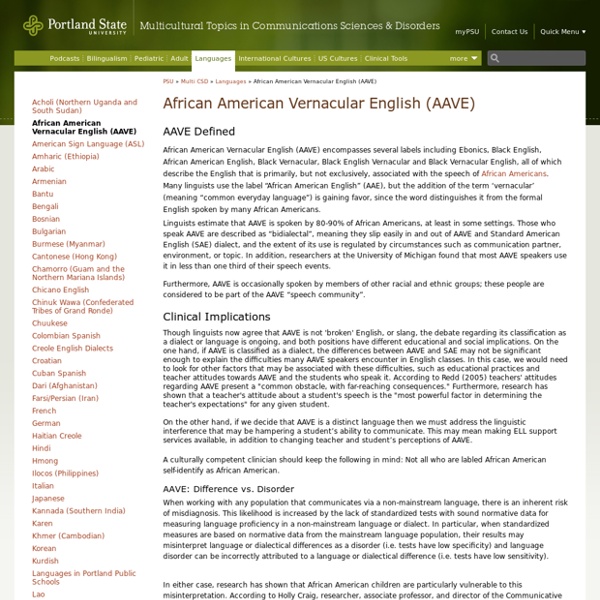Portland State Multicultural Topics in Communications Sciences & Disorders

https://www.pdx.edu/multicultural-topics-communication-sciences-disorders/african-american-vernacular-english-aave
Related: Multilingual resources assessment and intervention
All Kinds of Readers: A Guide to Creating Inclusive Literacy Celebrations for Kids with Learning and Attention Issues
Throughout the year, literacy events and celebrations can be a great way to get kids excited about books. When we celebrate reading, we send the message that reading matters, that it is important, and that it’s fun! However, it can be challenging to plan an event that appeals to kids who have difficulty with reading, or who may feel high levels of anxiety or discomfort about reading. This may be the case for kids with learning and attention issues such as dyslexia or ADHD. Henry Winkler, who has dyslexia, speaks to this feeling when he recalls that, as a kid, going to the library “would have been my worst nightmare: a whole room full of books that I couldn’t read.” He remembers, “To me, reading looked like a magic trick, and I wasn’t in on the secret.”
Identifying Language Impairment in ESL - Faculty of Arts
Page Navigation Resources Required to Use the Calculator SheetReporting the Results of the Calculators Effective identification of language impairment among ESL children requires comparing an ESL child's test scores to those of other ESL children. The information in this section was obtained by analyzing test scores from ESL children with and without language impairment.
Speech assessments - Multilingual Children's Speech
Speech-language pathologists frequently use single word and connected speech tests to assess children's speech production. The table below includes published tests and word lists that can be used to assess children's articulation and phonology in languages other than English. The aim is to be as comprehensive as possible in the table below. Inclusion in the table does not indicate endorsement or guarantee availability of an assessment. Some assessments can only be purchased by people who live in the country of publication, after attending a seminar, or upon providing professional qualifications. A review of some of the commercially available tests from the list below is here:
ESL option Jazz chants
Miles Craven presents a series of short jazz chants – a fun way to practise stress and rhythm in the classroom, to help your students sound more natural when they speak English. How to use Jazz Chants in the classroom You can use these jazz chants in a variety of fun ways. You can practice stress and rhythm with your class, to help your students sound more natural when they speak English.
Home
The Somali Literacy Project
Blogs on Bilingual Language Development 2 Languages 2 Worlds The Educational Linguist Research Bilingual Children with Primary Language Impairment Breadth and Depth of Diversity in Minnesota
Language Disorders in Multilingual and Multicultural Populations
The Speech Stop
NEW THERAPY TOOL - GROW! Language Development With Engaging Children's Stories. Check out the Bilingual Resources section or the informational flyer below for more detailed information. Story books are available in English only if you're not working with bilingual children. Available NOW! Click here to order.
African Storybook
Related:



